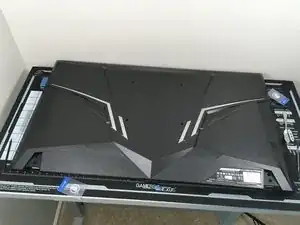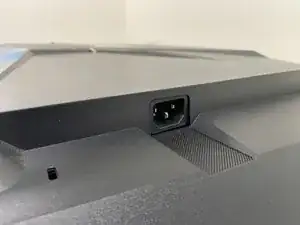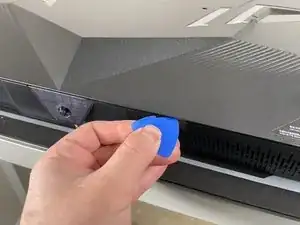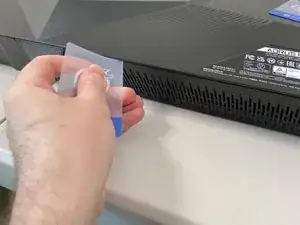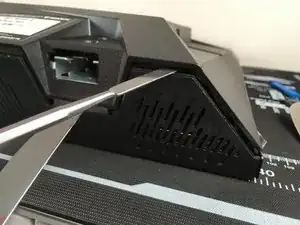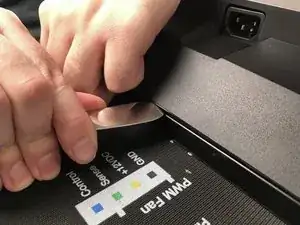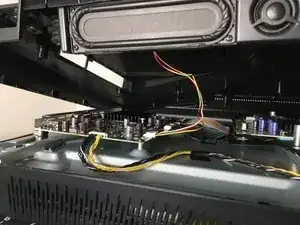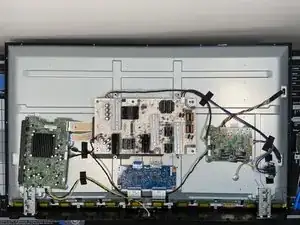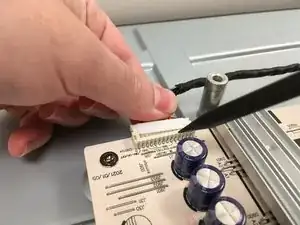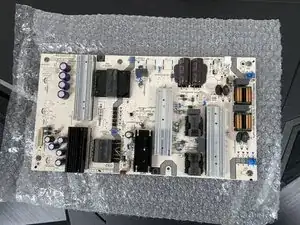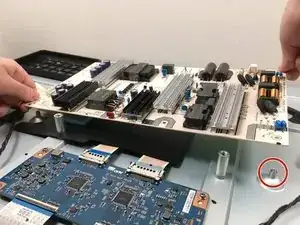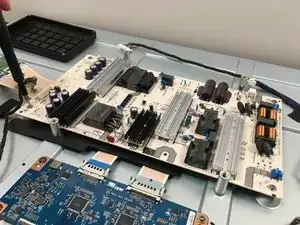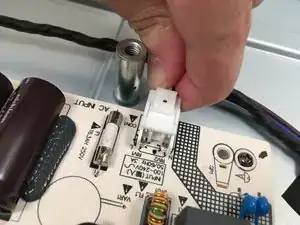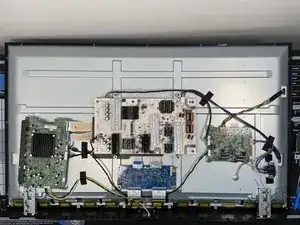Introduction
Follow this guide to replace the internal power supply of an Aorus FV43U.
One symptom of a faulty power supply is plugging the monitor in and hearing a "click" but the monitor status light and display not powering on.
Always follow electrostatic discharge (ESD) safety procedures when working on sensitive electronics like this monitor.
Tools
-
-
Unplug all cords from your monitor. Place your monitor face-down on a flat, non-slip surface, ensuring there is nothing on the surface which could scratch your monitor.
-
A clean project mat or non-slip pad would be ideal for this since the monitor will likely move around from the significant force required to remove the back panel.
-
-
-
If you are using the included feet or VESA mounting hardware, those need to be removed. This typically involves unscrewing 4 screws using a Phillips #2 head screwdriver, but may vary if you have a specialized mount.
-
-
-
To replace most of the components of the FV43U, you must enter from the back. The back panel is held in place entirely with plastic clips rather than screws.
-
Undoing these plastic clips takes significant force. Take your time and work carefully.
-
-
-
Start at the bottom under the model sticker. Insert your tools about 1/4" (~6.5mm). Use one to lift the back and turn the other gently until each clip "pops" itself out. Make sure you can get a good grip on your tools to avoid slipping, it does take significant force to open.
-
Work your way from here outwards to the sides. Be especially careful around the on-screen display (OSD) controls in the center. Do not pry directly above the joystick.
-
-
-
Once the bottom portion is free, begin prying up the corners. Use the area beneath the stand to gain leverage, and you should feel the side start to pop out as well.
-
Insert a Plastic Card to keep one side open while you work on the other side. The force exerted on one can inadvertently re-fasten the clips on the other.
-
-
-
Use your prying tool to work your way up the side of the display. Be careful not to insert your tool deeper than 1/4" (~6.5mm) or use the bezel as too much of a brace.
-
Once again use Plastic Cards to prevent the clips from re-fastening. Make sure both sides are free before prying open the top.
-
-
-
Unfastening the top is as simple as the sides - insert your prying tool about 1/4" (~6.5mm) and turn it gently until each clip "pops" itself out.
-
-
-
Gently lift the back panel from the bottom. Only lift as far as needed to access the speaker connector.
-
-
-
Disconnect the speaker cable by grasping its connector on both sides and gently pulling it straight out.
-
-
-
With the speaker cable disconnected, lift the back panel up and out from the monitor. This gives us a good look inside.
-
-
-
Power Supply - this is what we're replacing. These are sometimes external power bricks but are often internal like this one. Since it is uncovered, be very careful not to touch any of its components or solder joints.
-
Motherboard - this includes all the inputs and outputs for our display.
-
T-Con (Timing Controller) board
-
LED Driver board
-
-
-
There are three cables you'll need to disconnect from the power supply:
-
AC inlet power cable connector
-
Motherboard power cable connector
-
LED Driver power cable connector
-
-
-
Pull firmly on one side of the motherboard cable connector to loosen it and then pull the entire thing out. It may require "walking" it back and forth by pulling one side and then the other until it is free.
-
-
-
To disconnect the AC inlet cable, squeeze the clip on the connector housing and pull it straight out.
-
-
-
Use a Phillips #2 head screwdriver to unscrew all five 8mm screws located around the edges of the power supply.
-
-
-
The power supply will feel "stuck" to the monitor due to its thermal pad. Steadily but firmly lift the power supply straight out by the edges.
-
-
-
The bottom-right stand-off has a built-in nub for the power supply to rest on. Align the new power supply on this nub first.
-
Once it has been properly aligned, place it all the way down while making sure all five screw holes are aligned.
-
-
-
Use a Phillips #2 head screwdriver to screw the new power supply in using the five 8mm screws removed in Step 16.
-
Double-check that the thermal pad is making contact with the bottom of the new power supply.
-
-
-
Once the new power supply has been screwed in, reconnect the motherboard cable.
-
Ensure the connector is aligned, place it in the receptacle, and gently but firmly push down on both sides of the connector until fully seated.
-
-
-
Align the LED cable connector with its port, then place a finger on either side and gently push until fully seated.
-
-
-
This is what your internals should look like. Exactly the same as before, but with a new power supply.
-
-
-
Insert the back panel into the top of the monitor, then lower it until you can plug the speaker connector back in.
-
-
-
Gently insert the speaker cable connector into its receptacle and push evenly on it until fully seated.
-
-
-
Align the back panel by inserting it flush at the top, then gently lowering it down until it settles into place.
-
-
-
To fully re-latch the back panel, work backwards from the way you took it off. Firmly but evenly push down starting at the top and work your way down the sides. Finally, go across the bottom until everything looks flush.
-
If this replacement didn't solve your problem, look into the other major components highlighted in Step 11 to see if they might be the culprit.
